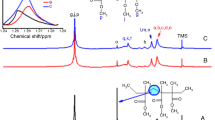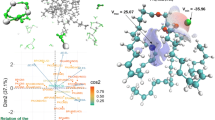Abstract
Natural-based polyols are seen by polyurethane industries as an alternative to the petroleum-based polyols because of increasing challenges due to the oil crisis and global warming. In this research, four different derivatives of bio-polyols are examined, which include the precursor Jatropha curcas oil (JC) that was extracted from Jatropha curcas seeds, as well as the derivatives epoxidated-polyol (EJ), hydroxylated epoxy-polyol (JP) and epoxy-polyurethane (JU). The computational studies provide more insight into their experimentally observed properties and can be useful in further customized design of this type of bio-polyols for industrial application. Results show that the JU monomer is more stable in terms of potential energy, level of atomic fluctuation, diffusion, radial distribution function, and with properties indicating the possibility of forming the best crystal solid. Monomer JU is also found to have the best resistance to acidic attack, using the results from the interaction energy, radial distribution function (RDF) and level of diffusion.

Graphical abstract












Similar content being viewed by others
References
Velayutham TS, Majid WHA, Ahmad AB, Kang GY, Gan SN (2009) Synthesis and characterization of polyurethane coatings derived from polyols synthesized with glycerol, phthalic anhydride and oleic acid. Prog Org Coat 66:367–371. https://doi.org/10.1016/j.porgcoat.2009.08.013
Petrović ZS, Cevallos MJ, Javni I, Schaefer DW, Justice R (2005) Soy-oil-based segmented polyurethanes. J Polym Sci Part B Polym Phys 43:3178–3190. https://doi.org/10.1002/polb.20607
Akintayo C, Akintayo ET, Thomas Z, Babalola BM (2014) Newly developed epoxy-polyol and epoxy-polyurethane from renewable resources. Br J Appl Sci Technol 3:984–993. https://doi.org/10.9734/bjast/2013/3985
Hwang H-S, Erhan SZ (2001) Modification of epoxidized soybean oil for lubricant formulations with improved oxidative stability and low pour point. J Am Oil Chem Soc 78:1179–1184. https://doi.org/10.1007/s11745-001-0410-0
Ismail EA, Motawie AM, Sadek EM (2011) Synthesis and characterization of polyurethane coatings based on soybean oil–polyester polyols. Egypt J Pet 20:1–8. https://doi.org/10.1016/j.ejpe.2011.06.009
Anjali BA, Suresh CH (2018) Electronic effect of ligands vs. reduction potentials of Fischer carbene complexes of chromium: a molecular electrostatic potential analysis. New J Chem 42:18217–18224. https://doi.org/10.1039/C8NJ04184A
Remya GS, Suresh CH (2018) Assessment of the electron donor properties of substituted phenanthroline ligands in molybdenum carbonyl complexes using molecular electrostatic potentials. New J Chem 42:3602–3608. https://doi.org/10.1039/C7NJ04592A
Remya K, Suresh CH (2016) Carbon rings: a DFT study on geometry, aromaticity, intermolecular carbon–carbon interactions and stability. R Socienty Chem Adv 6:44261–44271. https://doi.org/10.1039/c6ra06833b
Mohan N, Suresh CH, Kumar A, Gadre SR (2013) Molecular electrostatics for probing lone pair– p interactions. Physiol Chem Phys 15:18401–18409. https://doi.org/10.1039/c3cp53379d
Politzer P, Murray JS (2002) The fundamental nature and role of the electrostatic potential in atoms and molecules. Theor Chem Accounts 108:134–142. https://doi.org/10.1007/s00214-002-0363-9
Politzer P, Murray JS, Peralta-Inga Z (2001) Molecular surface electrostatic potentials in relation to noncovalent interactions in biological systems. Int J Quantum Chem 85:676–684. https://doi.org/10.1002/qua.1706
M.J. Frisch, G.W. Trucks, H.B. Schlegel, G.E. Scuseria, M.A. Robb, J.R. Cheeseman, G. Scalmani, V. Barone, G.A. Petersson, X. Nakatsuji, H. Li, M. Caricato, A. V. Marenich, J. Bloino, B.G. Janesko, R. Gomperts, B. Mennucci, H.P. Hratchian, J. V. Ortiz, A.F. Izmaylov, J.L. Sonnenberg, D. Williams-Young, F. Ding, F. Lipparini, F. Egidi, J. Goings, B. Peng, A. Petrone, T. Henderson, D. Ranasinghe, V.G. Zakrzewski, J. Gao, N. Rega, G. Zheng, W. Liang, M. Hada, M. Ehara, K. Toyota, R. Fukuda, J. Hasegawa, M. Ishida, T. Nakajima, Y. Honda, O. Kitao, H. Nakai, T. Vreven, K. Throssell, J.A. Montgomery, Jr, J.E. Peralta, F. Ogliaro, M.J. Bearpark, J.J. Heyd, E.N. Brothers, K.N. Kudin, V.N. Staroverov, T.A. Keith, R. Kobayashi, J. Normand, K. Raghavachari, A.P. Rendell, J.C. Burant, S.S. Iyengar, J. Tomasi, M. Cossi, J.M. Millam, M. Klene, C. Adamo, R. Cammi, J.W. Ochterski, R.L. Martin, K. Morokuma, O. Farkas, J.B. Foresman, D.J. Fox, Gaussian 16, revision B.01, (2016)
Dupradeau F-Y, Pigache A, Zaffran T, Savineau C, Lelong R, Grivel N, Lelong D, Rosanski W, Cieplak P (2010) The R.E.D. tools: advances in RESP and ESP charge derivation and force field library building. Phys Chem Chem Phys 12:7821–7839. https://doi.org/10.1039/c0cp00111b
D.A. Case, I.Y. Ben-Shalom, S.R. Brozell, D.S. Cerutti, I. T. E. Cheatham, V.W.D. Cruzeiro, T.A. Darden, R.E. Duke, D. Ghoreishi, M.K. Gilson, H. Gohlke, A.W. Goetz, D. Greene, R. Harris, N. Homeyer, S. Izadi, A. Kovalenko, T. Kurtzman, T.S. Lee, S. LeGrand, P. Li, C. Lin, J. Liu, T. Luchko, R. Luo, D.J. Mermelstein, K.M. Merz, Y. Miao, G. Monard, C. Nguyen, H. Nguyen, I. Omelyan, A. Onufriev, F. Pan, R. Qi, D.R. Roe, A. Roitberg, C. Sagui, S. Schott-Verdugo, J. Shen, C.L. Simmerling, J. Smith, R. Salomon-Ferrer, J. Swails, R.C. Walker, J. Wang, H. Wei, R.M.W. Wu, L. Xiao, D.M. York, P.A. Kollman, Amber 18, (2018)
Jorgensen WL, Chandrasekhar J, Madura JD, Impey RW, Klein ML (1983) Comparison of simple potential functions for simulating liquid water. J Chem Phys 79:926–935
Lehr GF, Lawler RG (1984) Quantitative CIDNP evidence for the SH2 reaction of alkyl radicals with Grignard reagents. Implication to the iron catalyzed Kharasch reaction. J Am Chem Soc 106:4048–4049. https://doi.org/10.1021/ja00326a035
Grant BJ, Rodrigues APC, ElSawy KM, McCammon JA, Caves LSD (2006) Bio3d: an R package for the comparative analysis of protein structures. Bioinforma 22:2695–2696. https://doi.org/10.1093/bioinformatics/btl461
Lu T, Chen F (2012) Multiwfn: a multifunctional wavefunction analyzer. J Comput Chem 33:580–592. https://doi.org/10.1002/jcc.22885
Lu T, Chen F (2012) Quantitative analysis of molecular surface based on improved marching Tetrahedra algorithm. J Mol Graph Model 38:314–323. https://doi.org/10.1016/j.jmgm.2012.07.004
Glendening ED, Streitwieser A (1994) Natural energy decomposition analysis: an energy partitioning procedure for molecular interactions with application to weak hydrogen bonding, strong ionic, and moderate donor – acceptor interactions natural energy decomposition analysis: an energy par. J Chem Phys 100:2900–2909. https://doi.org/10.1063/1.466432
Kazuo K, Keiji M (2004) A new energy decomposition scheme for molecular interactions within the Hartree-Fock approximation. Int J Quantum Chem 10:325–340. https://doi.org/10.1002/qua.560100211
S.R. Gadre, R.N. Shirsat, Electrostatics of atoms and molecules, Universities Press, India, 200AD
Gadre SR, Pathak RK (1990) Nonexistence of local maxima in molecular electrostatic potential maps. Proc Indian Acad Sci - Chem Sci 102:189–192. https://doi.org/10.1007/BF02860157
Gadre SR, Kulkarni SA, Pathak RK (1991) Reply to the comment on: maximal and minimal characteristics of molecular electrostatic potentials: some further extensions [2]. J Chem Phys 94:8639. https://doi.org/10.1063/1.460055
Gadre SR, Kulkarni SA, Shrivastava IH (1992) Molecular electrostatic potentials: a topographical study. J Chem Phys 96:5253–5260. https://doi.org/10.1063/1.462710
Li W, Yang N, Lyu Y (2016) A mechanistic study on guanidine-catalyzed chemical fixation of CO2 with 2-aminobenzonitrile to quinazoline-2,4(1: H,3 H)-dione. Org Chem Front 3:823–835. https://doi.org/10.1039/c6qo00085a
Kaul D, Kaur R (2015) Theoretical characterization of hydrogen bonding interactions between RCHO (R = H, CN, CF3, OCH3, NH2) and HOR′(R′ = H, Cl, CH3, NH2, C(O)H, C6H5). J Chem Sci 127:1299–1313. https://doi.org/10.1007/s12039-015-0885-z
Pettersen EF, Goddard TD, Huang CC, Couch GS, Greenblatt DM, Meng EC, Ferrin TE (2004) UCSF chimera–a visualization system for exploratory research and analysis. J Comput Chem 25:1605–1612. https://doi.org/10.1002/jcc.20084
ChemAxon, MarvinSketch, (2017). http://www.chemaxon.com
T. Williams, C. Kelley, J. Campbell, R. Cunningham, D. Denholm, G. Elber, R. Fearick, C. Grammes, L. Hart, L. Hecking, T. Koenig, D. Kotz, E. Kubaitis, R. Lang, A. Lehmann, A. Mai, M. Bastian, E. A Merritt, P. Mikul, T. Tkacik, J. Van Der Woude, J.R. Van Zandt, A. Woo, J. Zellner, Gnuplot 4.6, Softw. Man. (2012) 238
Humphrey W, Dalke A, Schulten K (1996) VMD: visual molecular dynamics. J Mol Graph 14:27–28-38
von Frantzius G, Streubel R (2010) Calculation of 31 P and 183 W NMR chemical shifts and nuclear spin coupling constants in phosphinidenoid and other transition metal complexes by the ZORA DFT method. In: Münster G, Wolf D, Kremer M (eds) Neumann Inst. Comput. Symp. Forschungszentrum Jülich, Jülich, pp 119–128
Riasat Harami H, Asghari M (2019) 3-aminopropyltriethoxysilane-aided cross-linked chitosan membranes for gas separation: grand canonical Monte Carlo and molecular dynamics simulations. J Mol Model 25. https://doi.org/10.1007/s00894-019-3929-3
M.A. Nejad, H.M. Urbassek, Adsorption and diffusion of cisplatin molecules in nanoporous materials: a molecular dynamics study, (2019). doi:https://doi.org/10.3390/biom9050204
Funding
The authors would like to acknowledge the University of the Free State and the NRF in South Africa for financial support (Grant Nos: 109673, 113327 and 96111), and CHPC for the simulation facilities.
Author information
Authors and Affiliations
Corresponding author
Ethics declarations
Conflict of interest
The authors declare that there is no conflict of interest.
Ethical statement
This study does not require any ethical clearance.
Additional information
Publisher’s note
Springer Nature remains neutral with regard to jurisdictional claims in published maps and institutional affiliations.
Electronic supplementary material
ESM 1
(DOCX 671 kb)
Rights and permissions
About this article
Cite this article
Adeniyi, A.A., Akintayo, C.O., Akintayo, E.T. et al. The conformational search, the stability, fragment interaction and resistance to acidic attack of epoxyl-polyurethanes in different solvent media. Struct Chem 31, 861–875 (2020). https://doi.org/10.1007/s11224-019-01470-2
Received:
Accepted:
Published:
Issue Date:
DOI: https://doi.org/10.1007/s11224-019-01470-2




